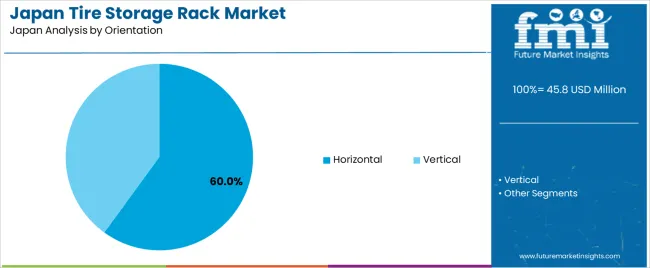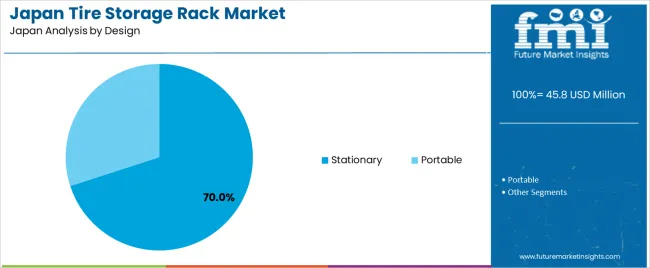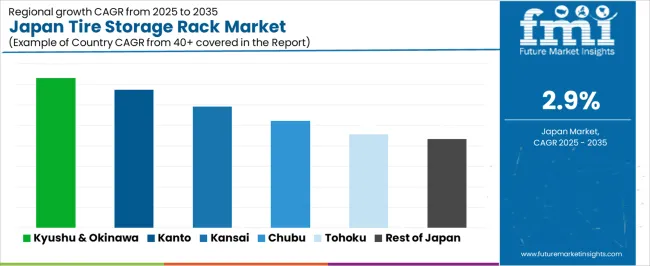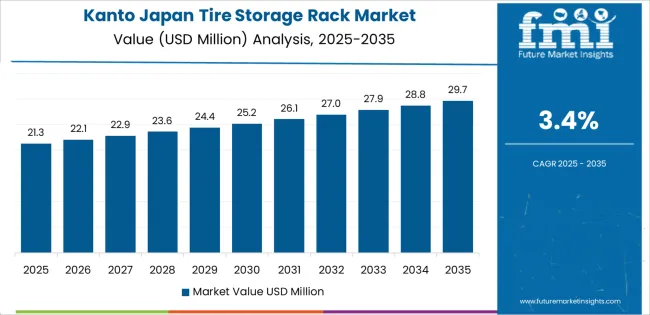The demand for tire storage racks in Japan is expected to grow steadily from USD 45.8 million in 2025 to USD 61.2 million by 2035, with a compound annual growth rate (CAGR) of 2.9%. This steady increase is driven by the ongoing need for efficient tire storage solutions across various industries, particularly in automotive retail, tire dealers, and service centers. As vehicle ownership continues to rise and tire demand grows, the need for organized, accessible, and safe storage solutions will remain essential for businesses managing tire inventory.
In the final phase of the forecast period, from 2030 to 2035, the demand for tire storage racks will experience an acceleration, rising by USD 8.2 million. The significant growth during this phase will be driven by the widespread adoption of advanced tire storage solutions, which will be integrated into a broader range of service and retail businesses. The increasing number of tire models and tire service requirements will push companies to invest in efficient storage systems. The need for innovation and operational optimization will lead to the adoption of smart storage technologies, further increasing demand.

Between 2025 and 2030, the demand for tire storage racks will increase from USD 45.8 million to approximately USD 53.0 million, adding USD 7.2 million. This phase will experience moderate growth as tire dealers and service centers continue to adopt more efficient storage solutions to optimize space and enhance inventory management. The early growth period will be driven by the increasing recognition of tire storage systems' benefits in improving operational efficiency, safety, and space management. During this time, growth will remain stable, supported by incremental advancements in storage system technology, but without significant acceleration.
From 2030 to 2035, the demand is expected to rise more sharply, growing from USD 53.0 million to USD 61.2 million, adding USD 8.2 million. This later phase of growth will be marked by a stronger demand for tire storage racks, driven by the continued expansion of the automotive sector, an increasing number of vehicle models, and the growing need for efficient tire storage solutions across tire retailers, service centers, and even small-scale businesses. As the industry matures, demand will be driven by the adoption of space-saving, innovative tire storage systems that improve operational efficiency and meet the industry's growing needs.
| Metric | Value |
|---|---|
| Demand for Tire Storage Rack in Japan Value (2025) | USD 45.8 million |
| Demand for Tire Storage Rack in Japan Forecast Value (2035) | USD 61.2 million |
| Demand for Tire Storage Rack in Japan Forecast CAGR (2025 to 2035) | 2.9% |
The demand for tire storage racks in Japan is growing as automotive businesses, repair shops, and tire distributors seek organized, space-efficient solutions for tire storage. With the increasing number of vehicles on the road, especially in a country like Japan where the automotive industry is highly advanced, the need for safe, regulated, and efficient tire storage solutions is becoming more important.
One of the key drivers is the growth in both consumer and commercial vehicle sales, along with the rise in tire replacement rates. Automotive businesses are looking for storage systems that maximize space while keeping tires in good condition, ensuring ease of access, and adhering to safety standards. This trend is particularly relevant for businesses offering seasonal tire changes, as tire storage is crucial for organizing and maintaining inventory.
As e-commerce and online tire sales grow, tire storage solutions that allow for easy sorting and quick access are in demand. Technological advancements in tire storage systems, including racks that offer better load-bearing capacity and ease of mobility, are further boosting the demand for these products in Japan. As automotive services continue to expand and evolve, the demand for efficient tire storage solutions is expected to grow steadily through 2035.
Demand for tire storage racks in Japan is segmented by capacity, orientation, and design. By capacity, demand is divided into 50-150 tires, 10-50 tires, up to 10 tires, 150-300 tires, 300-500 tires, and above 500 tires. The demand is also segmented by orientation, including horizontal and vertical, with horizontal leading the demand. In terms of design, demand is divided into stationary and portable, with stationary racks leading the demand. Regionally, demand is divided into Kanto, Kinki, Chubu, Kyushu & Okinawa, Tohoku, and the Rest of Japan.

Tire storage racks with a capacity of 50-150 tires account for 30% of the demand in Japan. This capacity range is popular among businesses and automotive workshops that need to store a moderate number of tires efficiently. These racks strike a balance between space optimization and the ability to store a substantial number of tires, making them ideal for medium-sized businesses, tire dealers, and service centers. The demand is driven by the need for organized, easily accessible tire storage solutions that can accommodate a range of tire sizes. As the automotive industry continues to grow, and as more businesses require optimized storage solutions, the 50-150 tire capacity racks will remain a dominant choice for tire storage in Japan.

Horizontal orientation accounts for 60% of the demand for tire storage racks in Japan. Horizontal racks are preferred because they provide efficient storage by maximizing available space and ensuring tires are stored in a stable position. This orientation allows for easy access, making it more convenient for employees to handle and organize tires. Horizontal racks are particularly favored by automotive service centers and businesses with high turnover in tire sales and replacements. They are ideal for storing tires in bulk, providing an efficient way to store large quantities of tires while maintaining organization and ease of accessibility. As businesses continue to prioritize storage efficiency and quick access to tires, horizontal storage racks will maintain their dominance in the industry.

Stationary tire storage racks account for 70% of the demand in Japan. These racks are typically more durable and designed to handle larger capacities, making them ideal for businesses and locations that require long-term, stable storage solutions. Stationary racks are designed to be set in a fixed location, providing greater stability and safety when storing a large number of tires. This design is particularly useful for automotive service centers, tire retailers, and warehouses where tire turnover is steady, and there is a consistent need for organized storage. The demand for stationary racks is driven by their ability to withstand heavy use and the need for reliable, long-term storage solutions. With the increasing demand for organized and safe tire storage, stationary racks will continue to dominate the industry in Japan.
Demand for tire storage racks in Japan is rising as automotive‑workshops, tyre dealers, garages and residential users seek efficient, space‑saving storage solutions. These racks help organise seasonal tyres, manage growing inventories and optimise compact urban spaces. Key drivers include the expansion of vehicle parc and tyre aftermarket services, limited warehouse/garage space especially in urban Japan (which drives vertical and modular rack adoption), and the growth of online tyre retail which requires organised storage and quick inventory turnover. Restraints include fluctuations in raw‑material prices (steel, aluminium) which impact manufacturing cost, high initial investment for heavy‑duty commercial racks, and the relatively mature pace of growth in some segments (e.g., residential) meaning that head‑count growth of end‑users is slow.
In Japan, demand for tyre storage racks is growing because many service businesses and vehicle owners require well‑organised storage for tyres, especially with the country’s strong seasonal tyre change culture and dense urban living conditions. Garages and dealers operate in limited space, and efficient vertical or modular rack systems enable better storage density. With e‑commerce tyre sales increasing, firms need storage solutions that facilitate fast inventory movement and retrieval. Home garage users facing space constraints also seek compact racks to store spare or seasonal tyres safely. As storage and operational efficiency become more important in the automotive aftermarket and for private owners, investment in dedicated tyre storage racks rises.
Technological and product innovations are driving this segment in Japan by introducing more efficient, space‑saving, and specialised storage rack designs tailored to local conditions. Examples include slim or wall‑mounted rack formats ideal for small garages, modular multi‑tier systems for commercial workshops, and racks using high‑durability steel or coated surfaces for long life. Some innovations address automation and inventory management for larger dealers or warehouses. Enhanced ease‑of‑assembly and improved safety features (e.g., anti‑tip anchors in compact spaces) make racks more attractive. Such improvements increase adoption by lowering the barrier for both residential and commercial users in Japan’s space‑constrained environment.
Despite favourable conditions, adoption faces several challenges in Japan. One major barrier is cost: high‑quality commercial rack systems involve significant expenditure, which may deter smaller garages or home users. Also, with many workshops or garages already equipped, replacement or upgrade cycles may be slow. Space constraints also mean installation may be difficult or require custom configurations, increasing complexity and cost. Raw‑material price volatility (steel, aluminium) influences product pricing and margins. For residential users, awareness of dedicated tyre racks may still be growing, and many may continue to store tyres in simpler ways (on the floor or in boxes) rather than invest in purpose‑built racks.

| Region | CAGR (%) |
|---|---|
| Kyushu & Okinawa | 3.7% |
| Kanto | 3.4% |
| Kinki | 3.0% |
| Chubu | 2.6% |
| Tohoku | 2.3% |
| Rest of Japan | 2.2% |
The demand for tire storage racks in Japan is growing across all regions, with Kyushu & Okinawa leading at a 3.7% CAGR. This growth is supported by increasing vehicle ownership and the rise in demand for efficient storage solutions. Kanto follows with a 3.4% CAGR, driven by the dense population and high vehicle count in urban areas like Tokyo. Kinki shows a 3.0% CAGR, influenced by the region's strong automotive industry. Chubu experiences a 2.6% CAGR, while Tohoku and the Rest of Japan show slower growth at 2.3% and 2.2%, respectively, supported by regional automotive activity and storage needs.
Kyushu & Okinawa is experiencing the highest demand for tire storage racks in Japan, with a 3.7% CAGR. The region's growth is largely attributed to an increasing number of vehicles and the corresponding need for efficient tire storage solutions. Kyushu, home to cities like Fukuoka, has seen a steady rise in automotive sales and vehicle ownership, driving demand for tire storage products, especially in households, garages, and small automotive businesses.
Okinawa, with its high tourism rate and a growing number of local vehicle owners, also contributes to the increase in tire storage needs. The region’s relatively warm climate leads to a higher demand for tire storage systems that protect tires from wear caused by prolonged exposure to heat and UV rays. As vehicle ownership continues to rise and the automotive sector in Kyushu & Okinawa expands, the demand for tire storage racks will continue to grow steadily.

Kanto is seeing steady growth in demand for tire storage racks, with a 3.4% CAGR. The region’s strong automotive industry, driven by Tokyo’s dense population and high vehicle ownership, is a key factor in this growth. With the growing number of vehicles on the road, there is an increasing need for efficient and space-saving storage solutions, particularly in urban areas where space is limited.
Kanto’s automotive and retail sectors are also contributing to the demand for tire storage racks, as more businesses and consumers seek organized solutions for tire storage in both commercial and residential settings. The increasing number of automotive maintenance and service centers in Kanto also plays a role, as these businesses require proper tire storage equipment. With the region’s large population and high vehicle ownership rate, demand for tire storage racks will continue to rise as consumers prioritize efficient and organized storage for their tires.
Kinki is experiencing steady demand growth for tire storage racks, with a 3.0% CAGR. The region’s strong automotive manufacturing base, particularly in cities like Osaka and Kyoto, is fueling the demand for tire storage racks. Kinki’s automotive industry, which includes major vehicle manufacturers, is driving both commercial and residential need for efficient tire storage solutions. As more vehicles are produced and sold in the region, the demand for proper tire storage equipment follows suit.
Kinki's growing number of vehicle owners and service providers in the automotive sector is contributing to the adoption of tire storage systems. The region’s emphasis on space efficiency, particularly in densely populated urban areas, is also playing a role in driving demand. Consumers are increasingly looking for ways to store tires securely and efficiently, especially as vehicle ownership increases and the need for tire storage becomes more apparent. As the automotive sector in Kinki continues to grow, the demand for tire storage racks is expected to rise steadily.
Chubu is experiencing moderate growth in demand for tire storage racks, with a 2.6% CAGR. The region’s automotive sector, particularly in cities like Nagoya, plays a key role in driving demand for tire storage solutions. As the automotive industry continues to expand, with both manufacturers and automotive service centers increasing in number, there is a growing need for efficient tire storage systems.
Chubu’s automotive maintenance and repair businesses are key drivers of this demand, as tire storage racks are essential for ensuring the proper care and organization of tires. The region’s focus on manufacturing and industrial activity, including automotive parts production, also supports the growth of the tire storage rack industry. As vehicle ownership continues to rise and the automotive industry in Chubu grows, the need for organized and efficient storage solutions for tires will likely continue to increase at a steady pace.
Tohoku is seeing moderate growth in demand for tire storage racks, with a 2.3% CAGR. The region’s growing automotive industry, driven by an increasing number of vehicles on the road, is contributing to the need for more tire storage solutions. As vehicle ownership continues to rise, particularly in rural and suburban areas, there is a growing need for organized storage to ensure tires are properly stored and maintained.
Tohoku’s increasing focus on improving infrastructure and vehicle-related services is also playing a role in boosting demand for tire storage racks. As more consumers and businesses in the region recognize the importance of protecting tires from damage and wear, the demand for efficient tire storage solutions is expected to grow. While the growth rate in Tohoku is slower than in more urbanized regions, the steady rise in vehicle ownership and the expansion of automotive services in the area will support continued demand for tire storage systems.
The Rest of Japan is experiencing modest growth in demand for tire storage racks, with a 2.2% CAGR. While demand is slower compared to more urbanized regions, the growing number of vehicle owners in rural areas is contributing to a steady rise in tire storage needs. As more people in these areas adopt cars and the number of small automotive businesses increases, the need for proper tire storage solutions is growing.
The Rest of Japan’s increasing focus on improving vehicle maintenance and organization, coupled with a shift toward more efficient and practical tire storage options, is helping to drive this demand. Although the growth rate is more moderate, the overall trend towards better automotive care and convenience in rural and less developed areas ensures that demand for tire storage racks will continue to grow at a steady pace.

Demand for tire storage racks in Japan is gaining momentum, driven by the increasing number of vehicles, the country’s established seasonal tire‐change practice, and the expanding automotive aftermarket infrastructure. With Japanese garages and service centers often constrained by space, there’s growing preference for efficient, vertically stacked, and modular tire storage solutions that optimise floor area and accommodate a wide variety of tire sizes. Urbanisation and the rise of compact living further fuel demand for tailored rack systems in commercial and residential settings.
In this Japanese demand context, FEMCO Holdings, LLC commands an estimated 30.0% share, reflecting its strong engagement in supplying custom and heavy‐duty tire storage rack systems suited for Japan’s automotive and logistics service facilities. Other important suppliers in the space include Steel King Industries, Inc., Martins Industries, Meiser GmbH, and Tier‑Rack Corporation, which deliver storage solutions designed to meet Japan’s high standards for durability, space efficiency, and operational safety.
Key drivers of demand in Japan include the proliferation of automotive workshops, tire retailers and service centres requiring robust storage infrastructure; the push for better inventory management and safer handling of tires in crowded urban environments; and the trend toward modular, adjustable racks that can adapt to seasonal pressures and varying tire sizes. While challenges such as raw‐material cost fluctuations (especially steel) and installation constraints in dense urban facilities can affect uptake, the overall outlook for tire storage racks in Japan remains positive.
| Items | Values |
|---|---|
| Quantitative Unit | USD million |
| Capacity | 50-150 Tires, 10-50 Tires, Up to 10 Tires, 150-300 Tires, 300-500 Tires, Above 500 Tires |
| Orientation | Horizontal, Vertical |
| Design | Stationary, Portable |
| Tire Type | Passenger Car Tires, LCV Tires, Truck Tires, 2 Wheeler Tires, Bicycle Tires |
| Material | Steel, Aluminium, Wire Mesh |
| Key Players Profiled | FEMCO Holdings, LLC, Steel King Industries, Inc., Martins Industries, Meiser GmbH, Tier-Rack Corporation |
| Additional Attributes | Dollar sales by capacity, orientation, design, tire type, material, and regional trends focusing on automotive storage needs |
The global demand for tire storage rack in Japan is estimated to be valued at USD 45.8 million in 2025.
The demand for tire storage rack in Japan is projected to reach USD 61.2 million by 2035.
The demand for tire storage rack in Japan is expected to grow at a 2.9% CAGR between 2025 and 2035.
The key product types are 50–150 tires, 10–50 tires, up to 10 tires, 150–300 tires, 300–500 tires and above 500 tires.
In terms of orientation, the horizontal segment is expected to command a 60.0% share in the demand for tire storage racks in Japan in 2025.






Our Research Products

The "Full Research Suite" delivers actionable market intel, deep dives on markets or technologies, so clients act faster, cut risk, and unlock growth.

The Leaderboard benchmarks and ranks top vendors, classifying them as Established Leaders, Leading Challengers, or Disruptors & Challengers.

Locates where complements amplify value and substitutes erode it, forecasting net impact by horizon

We deliver granular, decision-grade intel: market sizing, 5-year forecasts, pricing, adoption, usage, revenue, and operational KPIs—plus competitor tracking, regulation, and value chains—across 60 countries broadly.

Spot the shifts before they hit your P&L. We track inflection points, adoption curves, pricing moves, and ecosystem plays to show where demand is heading, why it is changing, and what to do next across high-growth markets and disruptive tech

Real-time reads of user behavior. We track shifting priorities, perceptions of today’s and next-gen services, and provider experience, then pace how fast tech moves from trial to adoption, blending buyer, consumer, and channel inputs with social signals (#WhySwitch, #UX).

Partner with our analyst team to build a custom report designed around your business priorities. From analysing market trends to assessing competitors or crafting bespoke datasets, we tailor insights to your needs.
Supplier Intelligence
Discovery & Profiling
Capacity & Footprint
Performance & Risk
Compliance & Governance
Commercial Readiness
Who Supplies Whom
Scorecards & Shortlists
Playbooks & Docs
Category Intelligence
Definition & Scope
Demand & Use Cases
Cost Drivers
Market Structure
Supply Chain Map
Trade & Policy
Operating Norms
Deliverables
Buyer Intelligence
Account Basics
Spend & Scope
Procurement Model
Vendor Requirements
Terms & Policies
Entry Strategy
Pain Points & Triggers
Outputs
Pricing Analysis
Benchmarks
Trends
Should-Cost
Indexation
Landed Cost
Commercial Terms
Deliverables
Brand Analysis
Positioning & Value Prop
Share & Presence
Customer Evidence
Go-to-Market
Digital & Reputation
Compliance & Trust
KPIs & Gaps
Outputs
Full Research Suite comprises of:
Market outlook & trends analysis
Interviews & case studies
Strategic recommendations
Vendor profiles & capabilities analysis
5-year forecasts
8 regions and 60+ country-level data splits
Market segment data splits
12 months of continuous data updates
DELIVERED AS:
PDF EXCEL ONLINE
Demand Signal Repository Solutions Market Size and Share Forecast Outlook 2025 to 2035
Demand Side Management Market Size and Share Forecast Outlook 2025 to 2035
Demand Response Market Analysis - Size, Share, and Forecast Outlook 2025 to 2035
North America Shipping Supplies Market Trends – Innovations & Growth 2024-2034
Demand of Kozani Saffron in Greece Analysis - Size, Share & Forecast 2025 to 2035
Demand of No-acid Whey Strained Dairy Processing Concepts in European Union Size and Share Forecast Outlook 2025 to 2035
Demand for Bronte Pistachio in Italy Analysis - Size, Share & Forecast 2025 to 2035
Demand and Trend Analysis of Gaming Monitor in Western Europe Size and Share Forecast Outlook 2025 to 2035
Demand and Trend Analysis of Gaming Monitor in Korea Size and Share Forecast Outlook 2025 to 2035
Demand and Trend Analysis of Gaming Monitor in Japan Size and Share Forecast Outlook 2025 to 2035
Glycine Soja (Soybean) Seed Extract Market Size and Share Forecast Outlook 2025 to 2035
Demand and Trend Analysis of Yeast in Japan - Size, Share, and Forecast Outlook 2025 to 2035
Demand of Pistachio-based desserts & ingredients in France Analysis - Size, Share & Forecast 2025 to 2035
Western Europe Men’s Skincare Market Analysis – Forecast 2023-2033
Demand and Trends Analysis of Stevia in Japan Size and Share Forecast Outlook 2025 to 2035
Japan Women’s Intimate Care Market Trends – Growth & Forecast 2024-2034
Demand and Trend Analysis of Fabric Stain Remover in Korea Size and Share Forecast Outlook 2025 to 2035
Demand and Sales Analysis of Paper Cup in Korea Size and Share Forecast Outlook 2025 to 2035
Demand and Sales Analysis of Paper Cup in Western Europe Size and Share Forecast Outlook 2025 to 2035
Demand of MFGM-enriched Powders & RTDs in European Union Size and Share Forecast Outlook 2025 to 2035

Thank you!
You will receive an email from our Business Development Manager. Please be sure to check your SPAM/JUNK folder too.
Chat With
MaRIA